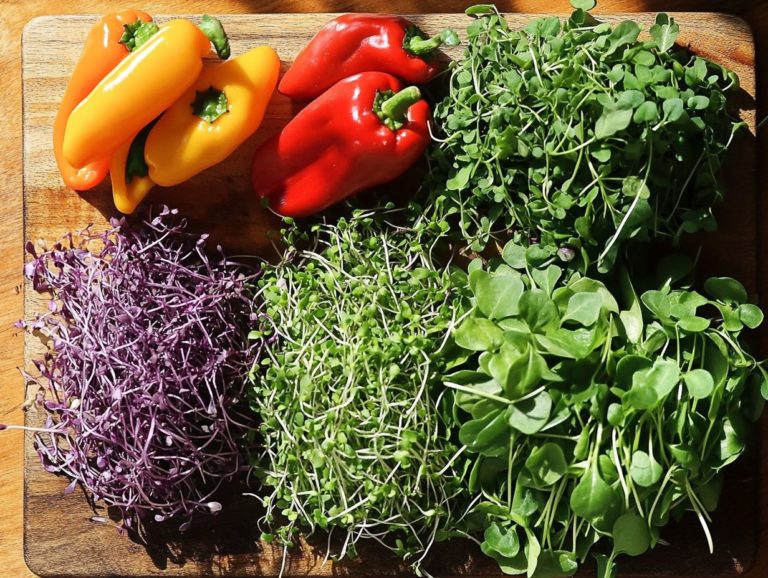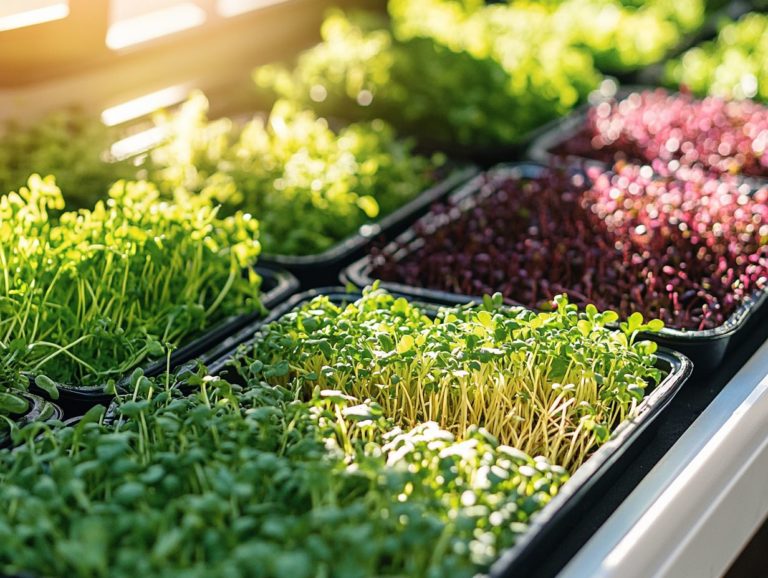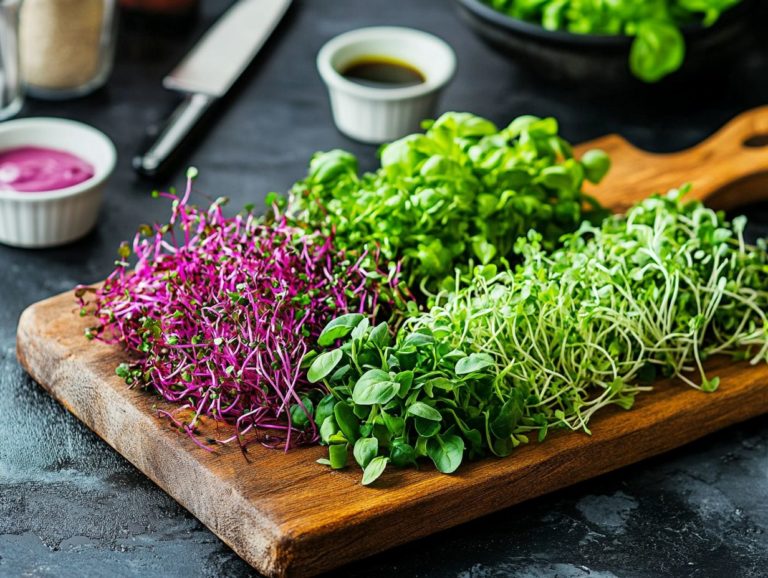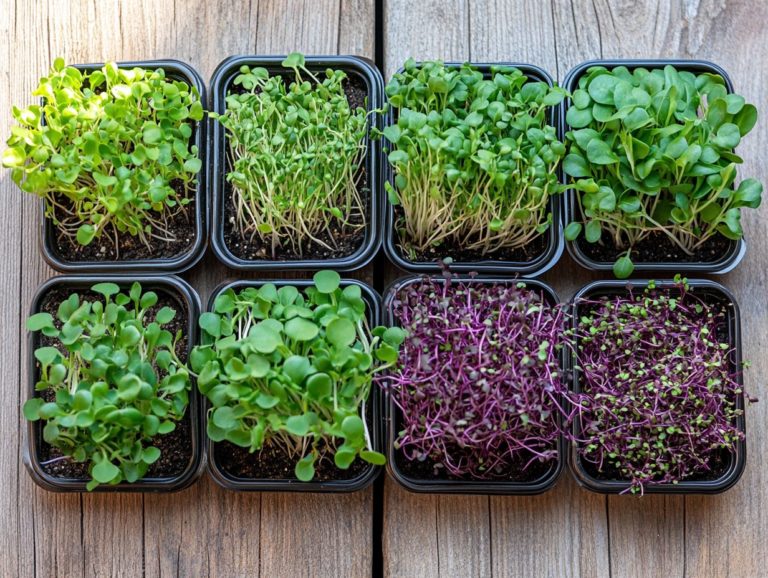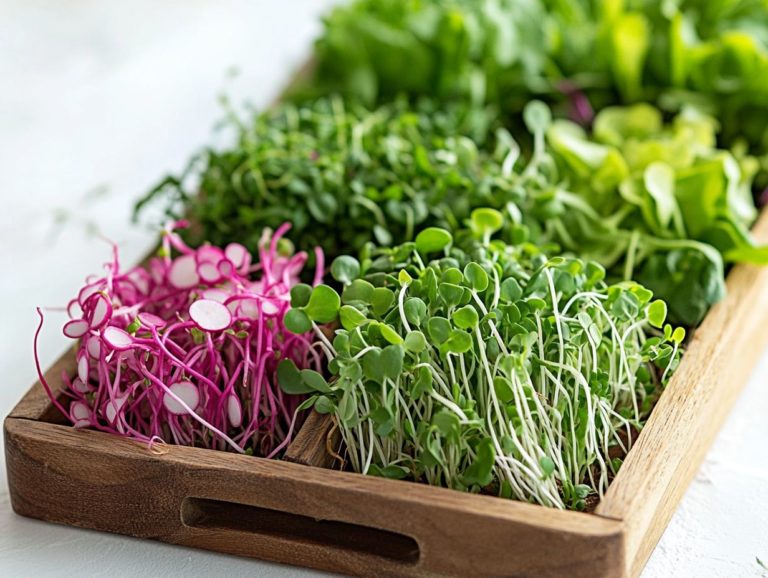5 Microgreen Varieties with Unique Textures
Microgreens are not just tiny plants; they are vibrant bursts of flavor and nutrients that appeal to both health-conscious individuals and culinary aficionados.
In this article, you’ll explore five remarkable varieties: Radish, Sunflower, Pea, Cabbage, and Broccoli Microgreens. Each variety boasts its own unique textures and tastes, enriching your culinary experience.
Learn how microgreens differ from sprouts. Discover their health benefits and get creative ideas for using them in your meals.
You will also find practical tips for growing and storing these delightful greens at home.
Jump in now and discover how microgreens can transform your kitchen adventures!
Contents
- Key Takeaways:
- 1. Radish Microgreens
- 2. Sunflower Microgreens
- 3. Pea Microgreens
- 4. Cabbage Microgreens
- 5. Broccoli Microgreens
- What Are Microgreens and How Are They Different from Sprouts?
- Frequently Asked Questions
- What are five microgreen varieties with unique textures, and what are their taste and texture profiles?
- How do broccoli microgreens add a unique texture to a dish?
- What texture do sunflower microgreens bring to a dish?
- How do radish microgreens enhance the texture of a dish?
- How do pea shoot microgreens contribute to the texture of a dish?
- What unique texture do amaranth microgreens bring to a dish?
Key Takeaways:

- Radish microgreens add a spicy kick to dishes and have a crunchy texture, perfect for sandwiches and salads.
- Sunflower microgreens have a nutty flavor and a crisp texture, making them a delicious addition to sandwiches, wraps, and stir-fries.
- Pea microgreens have a sweet and delicate flavor with a crunchy texture, versatile in salads, soups, and as a topping.
1. Radish Microgreens
Radish microgreens are an exceptional choice among microgreen varieties. They are celebrated for their quick growth and peppery flavor that adds a delightful kick to your dishes and salads.
These versatile greens thrive in soil that allows water to pass through easily and bask in sunlight. This makes them a rewarding option whether you re a beginner or a seasoned gardener.
Their unique taste crisp and slightly spicy distinguishes them from other microgreens, like pea shoots, which offer a sweet, mild flavor.
When you use radish microgreens as a garnish or incorporate them as a key ingredient, they elevate the visual appeal of your dishes. They contribute a complex texture that contrasts beautifully with softer ingredients.
Whether you re sprinkling them atop sandwiches or blending them into dressings, the zesty profile of these microgreens infuses a fresh vibrancy, transforming ordinary meals into delightful gourmet experiences.
2. Sunflower Microgreens
Sunflower microgreens are easy to grow and make a nutritious addition to your meals. Bursting with essential nutrients and a delightful crunch, they elevate the flavor of any dish.
These tiny greens carry a vibrant taste that echoes roasted sunflower seeds, adding a nutty nuance to your salads, sandwiches, and wraps.
Their tender leaves and crisp stems provide a satisfying texture that beautifully contrasts with softer ingredients.
With just a little space and care, you can cultivate these microgreens both indoors and outdoors. This grants you year-round access to a fresh, nutritious food source.
Rich in vitamins A, B, C, and E, sunflower microgreens support improved cardiovascular health and boost immunity. They are ideal for health-conscious individuals eager to elevate their meals.
3. Pea Microgreens
Pea microgreens are praised for their delightful sweetness and impressive nutrient profile. They are a standout choice among salad greens and a charming addition to various culinary creations, especially when paired with basil or cilantro.
These petite greens are brimming with vitamins A, C, and K, boosting both the flavor of your dishes and your overall wellness. They require minimal space and light, flourishing indoors or outdoors with consistent moisture and good drainage.
Their tender leaves and delicate stems can elevate a variety of meals, from garnishing soups to adding a refreshing crunch to sandwiches.
For the ultimate flavor experience, enjoy them fresh right after harvesting or lightly saut ed to enhance salads, tacos, and even grain bowls.
In conclusion, microgreens offer a burst of flavor and nutrition that can enhance your meals. Start experimenting with these delightful greens today!
4. Cabbage Microgreens

Cabbage microgreens rank among the most popular microgreens, offering a mild flavor and impressive health benefits that make them a versatile choice for various culinary endeavors. They often grow alongside mustard and cress.
These petite greens come in an array of varieties, each boasting its own unique taste and characteristics. For example, red cabbage microgreens deliver a subtle peppery bite. Meanwhile, green cabbage offers a sweeter, more nuanced flavor.
Savoy cabbage microgreens, with their tender, ribbed leaves, contribute a delightful texture that can elevate any dish.
Cultivating these nutrient-dense greens is surprisingly straightforward. They flourish in well-draining soil and require ample light. Incorporating cabbage microgreens into your salads, sandwiches, or wraps enhances flavor and boosts nutritional value, creating a wonderful opportunity to elevate your everyday dining experience.
5. Broccoli Microgreens
Broccoli microgreens are a sustainable crop that truly shines with their high nutrient content and remarkable health benefits. They are an essential addition to your healthy diet and are often included in smoothies for a nutrient boost.
These tiny greens pack a powerful punch of vitamins, including A, C, E, and K, along with essential minerals like calcium and iron, all while being low in calories. You can easily grow them right at home in just a few days on your windowsill or countertop, requiring minimal resources and care.
Their vibrant flavor and crisp texture make them the perfect garnish for various dishes. Imagine tossing them into salads, blending them into smoothies, or using them as a delightful topping on sandwiches.
Don’t miss out on the chance to elevate your dishes with broccoli microgreens! Consider adding them to a fresh spring roll or sprinkling them over a warm bowl of grains for that extra nutrient boost.
What Are Microgreens and How Are They Different from Sprouts?
Microgreens are the young, edible greens you harvest just after the first true leaves make their appearance. They are often grown hydroponically, which means they grow in a nutrient-rich water solution instead of soil. This method stands apart from sprouts, which are simply germinated seeds consumed whole and lack the true leaves that define microgreens.
As you delve into the world of microgreens, you’ll discover a vibrant tapestry of plant families crucifers, sunflowers, and legumes all offering an exciting array of flavors and textures. For a deeper understanding of these unique options, check out the microgreen varieties: taste and flavor guide. Culinary enthusiasts cherish their versatility, seamlessly incorporating them into salads, sandwiches, and garnishes to enhance both taste and presentation.
Nutritionally, microgreens are a powerhouse, often boasting higher concentrations of vitamins, minerals, and antioxidants compared to their mature counterparts. This makes them an exceptional addition to any meal.
While sprouts are nutritious in their own right, they typically fall short in flavor richness and diversity, underscoring the distinctive advantages that microgreens bring to your dining experience.
What Are the Health Benefits of Microgreens?
Microgreens present an impressive array of health benefits, rich in nutrients and antioxidants that significantly enhance your overall well-being. They also serve as a sustainable crop, perfect for elevating your culinary creations.
Easily added to a wide range of dishes, these petite greens deliver a powerful nutritional punch, brimming with essential vitamins such as A, C, E, and K, along with vital minerals like calcium, iron, and magnesium.
For example, a study featured in the Journal of Agricultural and Food Chemistry revealed that certain microgreens, such as radish and broccoli, can boast nutrient concentrations up to 40 times greater than their mature counterparts.
This elevates them beyond simple garnishes to formidable allies in enriching the nutritional profile of your meals. They support heart health, strengthen the immune system, and even reduce inflammation.
How Can Microgreens Be Used in Cooking?
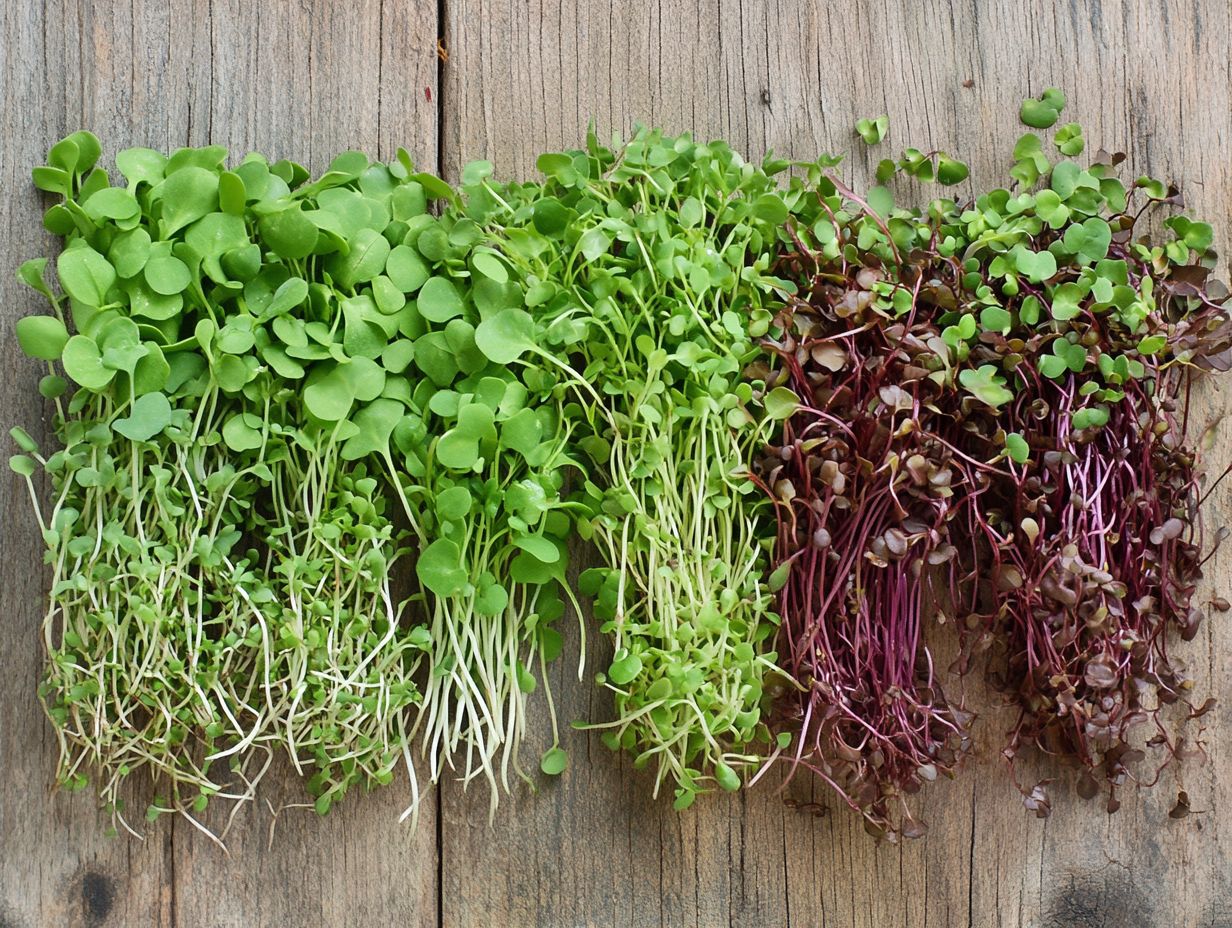
Microgreens can be a game-changer in your cooking! They offer distinct flavors and textures that elevate your dishes, from salads to sandwiches and beyond.
Imagine vibrant pea shoots adding a sweet crunch to your hearty grain salad. Or consider how spicy radish microgreens can deliver a zesty kick to your classic turkey sandwich! When you experiment with microgreens, it’s crucial to consider their unique profiles. For a comprehensive overview, check out microgreen varieties: a guide for beginners.
Delicate herbs like basil or cilantro pair beautifully with creamy dishes such as avocado toast or pasta primavera. On the flip side, heartier varieties like sunflower or beet microgreens can enhance grilled meats and roasted vegetables, introducing a fresh element that balances richness.
By thoughtfully incorporating these tiny greens, you can transform ordinary meals into extraordinary culinary delights!
What Are the Different Types of Microgreens?
There s a world of microgreens out there! Each type boasts its unique flavor profiles and characteristics. You can find everything from familiar favorites like basil and cilantro to more exotic varieties such as amaranth and sorrel.
These tiny greens don’t just bring vibrant colors to your dishes; they also offer distinct tastes. You can enjoy the peppery kick of arugula or the subtle sweetness of sunflower microgreens. Culinary enthusiasts often elevate their creations by using them as garnishes, tossing them into salads, or layering them on sandwiches and wraps. For a nutritious boost, consider adding the top microgreens for smoothies to your blend.
Growing conditions for microgreens can be quite diverse. Some thrive in bright light, while others prefer a bit of partial shade. These little greens are very nutritious, often containing higher concentrations of vitamins and minerals than their mature counterparts. Incorporating them into your diet is a surefire way to boost your health.
How Can One Grow Microgreens at Home?
Growing microgreens at home is not just easy; it s a delightful journey! It invites you to savor fresh flavors and unlock a spectrum of nutrients. Many varieties thrive in minimal spaces and offer a quick harvest time. This makes growing microgreens an ideal pursuit for anyone.
These petite greens can flourish in various settings, from sunny windowsills to dining tables. They are perfectly suited for urban dwellers or those who may not have a green thumb. To embark on this venture, gather essential materials: seed trays, potting soil, and the seeds of your chosen microgreens like radishes, peas, arugula, or sunflowers. Additionally, explore the benefits of growing diverse microgreen varieties, such as kohlrabi, carrots, beetroot, and wheatgrass.
For optimal growth, ensure ample light, preferably from a south-facing window or under grow lights. Maintain a steady temperature around 70 F. Regular watering is essential, but be cautious; over-saturation can invite unwelcome mold.
If you encounter any hiccups, like leggy plants or discolored leaves, a simple tweak in light exposure or watering frequency can often restore your greens to their vibrant best. Enjoy the process and relish the results!
What Are the Best Ways to Store and Preserve Microgreens?
Proper storage and preservation techniques for microgreens are essential! They maintain their freshness and nutrient content, ensuring they remain a healthy addition to your meals. Hydroponically grown varieties, in particular, can benefit significantly from these methods.
By implementing effective methods like refrigeration and drying, you can significantly extend the lifespan of these vibrant greens. When refrigerating microgreens, opt for breathable containers, ideally lined with paper towels to absorb excess moisture. This helps retain their delightful crunch and flavor.
Drying is also a great option for those who wish to preserve their microgreens for longer without sacrificing taste. It s crucial to keep an eye on temperature and humidity levels during storage, as these factors significantly influence the integrity of your microgreens.
By utilizing these techniques, you enhance their longevity and ensure they continue to deliver maximum nutritional benefits!
Ready to try growing microgreens at home? Dive into the world of tiny greens and discover their amazing flavors today!
Frequently Asked Questions
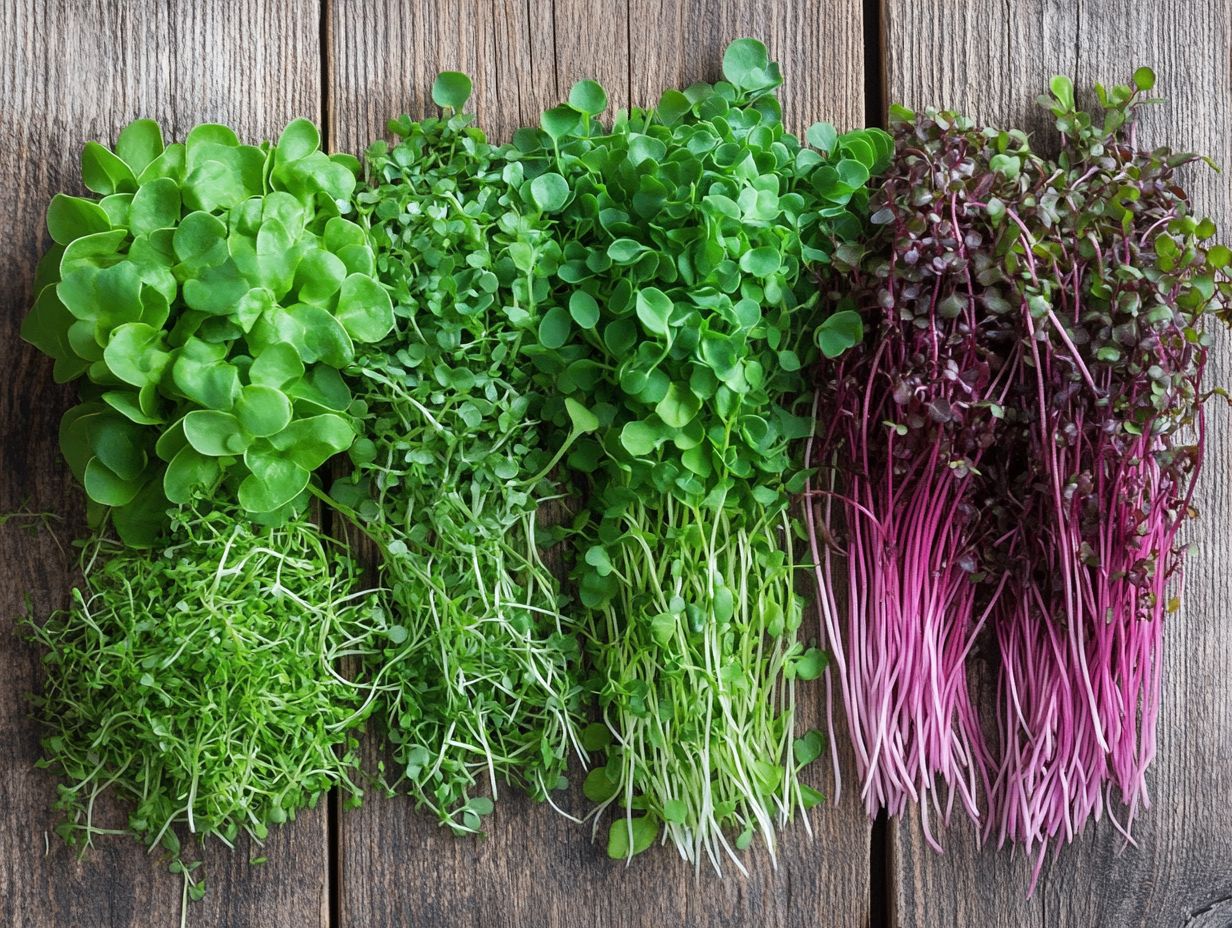
What are five microgreen varieties with unique textures, and what are their taste and texture profiles?
Here are five microgreen varieties with unique textures: broccoli, sunflower, radish, pea shoots, and amaranth.
How do broccoli microgreens add a unique texture to a dish?
Experience the wonderful crunch of broccoli microgreens! They can transform your salads and sandwiches.
What texture do sunflower microgreens bring to a dish?
Sunflower microgreens bring a delightful touch to your meals. You’ll love their tender texture!
How do radish microgreens enhance the texture of a dish?
Radish microgreens add a spicy punch! They re perfect for giving your dishes an extra kick.
How do pea shoot microgreens contribute to the texture of a dish?
Pea shoot microgreens are soft and refreshing. Try them in a smoothie for a tasty boost!
What unique texture do amaranth microgreens bring to a dish?
Amaranth microgreens are a feast for the eyes and taste buds. Add them to your salads for a beautiful touch!

